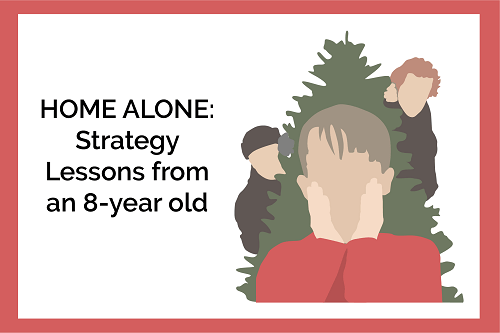 I was recently watching the classic Christmas comedy, Home Alone. You might recall that in the movie, the extended McCallister family travels to Europe for the Christmas holidays only to realize later that they have left their eight-year-old son Kevin at home. The movie centers on how Kevin handles his newfound freedom and the threat from two burglars who try to break into the home. Kevin’s handling of the situation contains several important strategy lessons.
I was recently watching the classic Christmas comedy, Home Alone. You might recall that in the movie, the extended McCallister family travels to Europe for the Christmas holidays only to realize later that they have left their eight-year-old son Kevin at home. The movie centers on how Kevin handles his newfound freedom and the threat from two burglars who try to break into the home. Kevin’s handling of the situation contains several important strategy lessons.
KNOW YOUR ENVIRONMENT
Kevin knew his home. He assessed the various egress points in and out of the residence and took inventory on what might help him turn the odds in his favor.
When was the last time you took an inventory of where your business stands? When was the last time an organizational assessment was performed in your organization? Do you have a recent SWOT (Strengths, Weaknesses, Opportunities, Threats) analysis? Do you know who and what threatens your organization? How has your business environment changed, especially considering the COVID pandemic? Understanding both the micro and macro environment of your organization is crucial and the first step in developing a winning strategy!
STRATEGY IS IMPORTANT
Kevin was outnumbered, outsized, and had a limited number of options available to him. He developed a plan to defend his home based on his assessment and his vision of thwarting the efforts of the two bungling burglars from stealing the McCallister family’s belongings. His mission was simply to impede the burglars’ abilities to complete their task by developing a strategy to inflict as much interference and deterrence as possible.
Is there a direct link between your mission and vision to your strategy? Was your strategic plan created in such a way to align your organization to where it wants to be in the next five years? A strategy that is not linked to the mission and vision of your organization is not strategic!
INNOVATE
Kevin did not have the ability to go purchase new gadgets and technology. He had to do the best with what he had available. By being creative and envisioning how he could differently utilize these things, he was able to create an impressive defense of his home.
Sometimes an organization must make do with what they already have. It may be the only choice! The question is how organizations respond to this. Instead of negativity, does creativity and innovation become the new focus? Do your leaders and employees notch up their performance, thinking, productivity and develop new ways of doing things in a more organized and competent manner? Or are they paralyzed with fear, both mentally and in their daily work?
BE AGILE AND HAVE A CONTINGENCY PLAN
Despite the best plan, plans will change. Kevin did not just depend on a single component of his strategy. He realized there were multiple entry points to the residence and tried to account for all of them. He had fallback positions and escapes planned in the event all did not go as planned.
Many organizations get stuck assuming the plan they have will carry them through to the next planning cycle. Further, many organizations fail to utilize contingency planning when developing strategic plans. Asking “What if…” is an important part of developing a sound strategy. COVID-19 caught most of us off-guard and completely unprepared for its impact on organizations throughout the world. While it is not possible to plan for every possible scenario, some planning in this area is better than none.
EXECUTION IS A MUST
Kevin executed on his plan. He successfully carried out the various stages of his defensive network built in his home and ultimately foiled the burglary which culminated in the arrest of the burglars. At any point, had he not executed his plan, failure may have been the result and the outcome not what was envisioned.
How well does your organization execute its strategy? Are your departments, business units, bureaus and employees aligned to your organizational strategy? Do they even understand your strategy? At the root of execution is the employee. If he or she does not understand how their role impacts what the organization is attempting to accomplish, then how can they be expected to successfully execute their respective roles? Strategy without execution is meaningless. Strategy fails or succeeds on how an organization is able to translate that strategy into action at the operational and individual levels of the organization.
The Balanced Scorecard Nine Steps to Success™ strategy management system encompasses the framework for allowing your organization to be successful in strategy development and successful execution of that strategy. It enables organizations to be innovative, to plan for contingencies and be readily adaptable to changes in the work environment.
Terry is Balanced Scorecard Institute's Director of Training and Senior Associate with over 30 years of experience working in both the private and public sectors.


